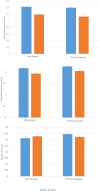The effect of push frequency and stroke time on wheelchair maneuverability among wheelchair tennis athletes on hard tennis court
- PMID: 39733074
- PMCID: PMC11682048
- DOI: 10.1038/s41598-024-83127-7
The effect of push frequency and stroke time on wheelchair maneuverability among wheelchair tennis athletes on hard tennis court
Abstract
Wheelchair propulsion is a fundamental skill in wheelchair sports, particularly in wheelchair tennis. To achieve optimal mobility during wheelchair athletic performance, it is essential to consider propulsion techniques. This study examines the effect of push frequency and stroke duration on wheelchair maneuverability, measured by velocity during propulsion, among wheelchair tennis athletes. The athletes (N = 9; 5 elite and 4 novice) performed three tests; namely the comfortable speed propulsion test, sprint test and round-trip test; with and without holding their racquet, over their hard court. Results revealed that push frequency had positive correlation with propulsion velocity (r = 0.840, p < 0.001) while stroke time was negatively correlated with velocity (r = -0.859, p < 0.001). Propulsion performance between elite and novice wheelchair athletes, and between propelling with and without racquet were also reflected through these parameters. The rate of perceived exertion (RPE) had significantly positive but low correlation with velocity and push frequency, and significant negative correlation with stroke time. This study could serve as a recommendation for wheelchair tennis athletes and coaches in planning their training protocols and techniques.
Keywords: Propulsion; Push frequency; Stroke time; Wheelchair athletes; Wheelchair tennis.
© 2024. The Author(s).
Conflict of interest statement
Declarations. Competing interests: The authors declare no competing financial and non-financial interests.
Figures



Similar articles
-
The Effect of a Newly Developed Hand Rim on Mobility Performance and Propulsion Technique in Wheelchair Tennis Players.Int J Sports Physiol Perform. 2024 Sep 4;19(11):1343-1346. doi: 10.1123/ijspp.2023-0492. Print 2024 Nov 1. Int J Sports Physiol Perform. 2024. PMID: 39231492
-
Sprint performance and force application of tennis players during manual wheelchair propulsion with and without holding a tennis racket.PLoS One. 2022 Feb 4;17(2):e0263392. doi: 10.1371/journal.pone.0263392. eCollection 2022. PLoS One. 2022. PMID: 35120157 Free PMC article.
-
Effect of holding a racket on propulsion technique of wheelchair tennis players.Scand J Med Sci Sports. 2017 Sep;27(9):918-924. doi: 10.1111/sms.12701. Epub 2016 May 27. Scand J Med Sci Sports. 2017. PMID: 27230534
-
The interaction between wheelchair configuration and wheeling performance in wheelchair tennis: a narrative review.Sports Biomech. 2024 Mar;23(3):370-391. doi: 10.1080/14763141.2020.1840617. Epub 2021 Jan 12. Sports Biomech. 2024. PMID: 33433269 Review.
-
The ergonomics of wheelchair configuration for optimal performance in the wheelchair court sports.Sports Med. 2013 Jan;43(1):23-38. doi: 10.1007/s40279-012-0005-x. Sports Med. 2013. PMID: 23315754 Review.
References
-
- Van der Slikke, R., Berger, M., Bregman, D. & Veeger, D. Push Characteristics in Wheelchair Court Sport Sprinting. Proc. Eng.147, 730–734. 10.1016/j.proeng.2016.06.265 (2016).
-
- Yang, Y. S., Koontz, A. M., Yeh, S. J. & Chang, J. J. Effect of backrest height on wheelchair propulsion biomechanics for level and uphill conditions. YAPMR93(4), 654–659. 10.1016/j.apmr.2011.10.023 (2012). - PubMed
-
- Mason, B. S., Lemstra, M., van der Woude, L. H. V., Vegter, R. & Goosey-Tolfrey, V. L. Influence of wheel configuration on wheelchair basketball performance: Wheel stiffness, tyre type and tyre orientation. Med. Eng. Phys.37(4), 392–399. 10.1016/j.medengphy.2015.02.001 (2015). - PubMed
-
- Sauret, C., Vaslin, P., Lavaste, F., de Saint Remy, N. & Cid, M. Effects of user’s actions on rolling resistance and wheelchair stability during handrim wheelchair propulsion in the field. Med. Eng. Phys.35(3), 289–297. 10.1016/j.medengphy.2012.05.001 (2013). - PubMed
-
- Tomlinson, J. D. Managing Maneuverability and Rear Stability of Adjustable Manual Wheelchairs: An Update. Physical Therapy80(9), 904–911. 10.1093/ptj/80.9.904 (2000). - PubMed
MeSH terms
LinkOut - more resources
Full Text Sources

